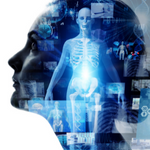Serotonin Syndrome versus Neuroleptic Malignant Syndrome

With an estimated 1 in 6 individuals in the US taking at least one psychotropic medication, prescribers will need to be aware of the potential side effects ranging from mild to life-threatening. The most prescribed psychotropic medications are antidepressants, followed by anxiolytics and antipsychotics. If you are a prescriber, your patients need to be aware of potentially harmful drug effects and what symptoms warrant immediate medical intervention. In the acute care setting, providers should consider medication side effects within the differential for any patient taking psychotropic medications who present with critical mood and mental status changes.
Serotonin Syndrome (SS)
The development of serotonin syndrome is linked to drug use or conditions that cause changes in serotonin metabolism by a variety of mechanisms, increased release of serotonin, impaired serotonin reuptake, inhibition of serotonin metabolism, or direct antagonism of serotonin’s effects. A wide variety of prescription psychotropic medications can have such effects – SSRIs, SNRIs, DNRIs, serotonin modulators, tricyclic antidepressants, and MAOIs. Prescribed non-psychotropic medications are ondansetron, dextromethorphan, cyclobenzaprine, and antiepileptics, which impact serotonin metabolism. Illicit drugs affecting serotonergic metabolism include amphetamines, cocaine, ecstasy, and LSD. One key consideration is that SS is concentration-dependent with increased risk with higher dosing of a single agent or multiple medications that impact serotonin metabolism. Sternbach’s Diagnostic Criteria outline the coincidence of at least three clinical symptoms suggestive of SS with the addition or increase of serotonergic medicines.
HeNeuroleptic Malignant Syndrome (NMS)

NMS’s underlying pathophysiology is less clear. However, tied to the use of drugs classified as dopamine antagonists, primarily first and second-generation antipsychotics. Unlike SS, the drug reaction involved with NMW is idiosyncratic, and thus a reaction may occur regardless of dosing. Risk factors include a prior history of NMS, preexisting catatonia, or central nervous system dysfunction. There are currently no widely accepted diagnostic criteria for NMS, though a non-validated expert consensus describes clinical presentation suggestive of NMS. In the setting of medication use that involved the blockade of dopamine, the following symptom tetrad has > 95% sensitivity and specificity for NMS:
- Mental status changes (agitation, delirium, confusion, catatonia)
- Muscle rigidity (i.e., “Lead pipe” rigidity or “cogwheeling”)
- Hyperthermia (temperature > 38°C)
- Autonomic instability (tachycardia, blood pressure lability, tachypnea, diaphoresis)
How do you tell the difference? – History is the most helpful element in clinically differentiating the two syndromes. As serotonin syndrome may be triggered by a wide variety of medications, a detailed medication history (prescription, OTCs, street drugs) and timeline related to drug use about symptom onset is vital. In addition, medical comorbidities that impact drug metabolism should also assess as liver, and renal dysfunction may potentiate drug effects.
Timeline
An understanding timeline can help with differentiation in that SS presents with 24 hours of medication initiation/changes while NMS takes between 72 hours and 14 days to develop. The physical exam involves several overlapping symptoms such as markers of autonomic instability, sialorrhea, diaphoresis, and eventually coma. However, hyperreflexia and clonus are more suggestive of SS. In terms of diagnostics, lab values can be helpful in the differentiation of the two syndromes as though SS can present with an increased leukocyte count or elevated transaminase levels. However, it occurs with minimal or no changes in laboratory findings. Laboratory values in NMS may include non-specific increases in leukocytes, creatinine phosphokinase(CPK), myoglobin, AST, ALT, and LDH. Although not diagnostic criteria, a triad of increased CPK, leukocytosis, and decreased serum iron level is more specific for NMS diagnosis. Neuroimaging can help rule out other underlying causes; however, CT and MRI are typically standard with both syndromes.
Treatment
The primary initial management, regardless of the drug implicated, includes identifying the correct diagnosis, withdrawal of the drug, and supportive care. Both clinical syndromes thus require referral to emergency medicine for immediate evaluation, monitoring, and a timely laboratory workup. While SS may range from mild to life-threatening, NMS should consider life-threatening as its progression is swift with up to a 20% mortality rate related to cardiac, respiratory, or renal failure.
Skin Bones CME Conferences
Hit the reset button while earning continuing medical education credits at our CME conferences, where you can travel to a vacation destination; earn CME credits with like-minded nurse practitioners, physician assistants, and physicians; and ‘unplug’ while enjoying a new locale! Check out our upcoming Skin, Bones, Hearts & Private Parts 2023 CME Conferences and 2024 CME Conferences! At every event, the best of the medical community gathers to earn CME credits, network, and gain knowledge on dermatology, orthopedics, cardiology and emergency medicine, women’s health, pain management and pharmacology, diabetes, ER, and mental health. On-line CME courses and Virtual CME are also available so you have the option of earning CME credits online.
See Melissa Kalensky speak at a 2022 Skin, Bones, Hearts & Private Parts CME Conference. Click here to find out where you can see her live and in-person!